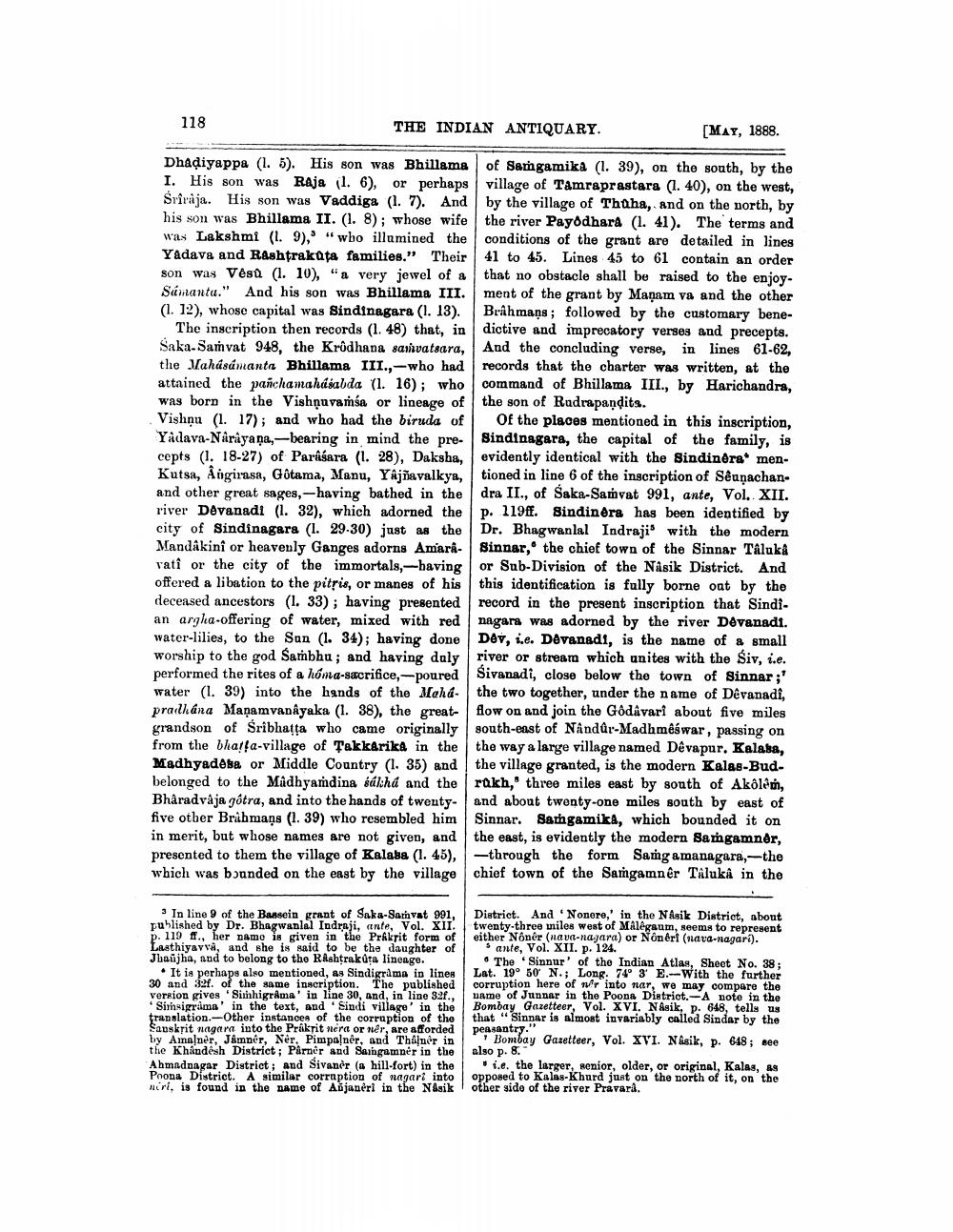________________
118
THE INDIAN ANTIQUARY.
[MAY, 1888.
Dhadiyappa (1. 5). His son was Bhillama of Samgamika (1. 39), on the south, by the I. His son was Raja 1. 6), or perhaps village of Tamraprastara (1. 40), on the west, Sriraja. His son was Vaddiga (1. 7). And by the village of Thaha, and on the north, by his son was Bhillama II. (1. 8); whose wife the river Payodhara (1. 41). The terms and was Lakshmi (1.9), "wbo illumined the conditions of the grant are detailed in lines Yadava and Rashtrakata families." Their 41 to 45. Lines 45 to 61 contain an order son was Vesů (1. 10), "a very jewel of a that no obstacle shall be raised to the enjoySúmantu." And his son was Bhillama III. ment of the grant by Maņam va and the other (1. 12), whose capital was Sindinagara (1. 13). Brahmans; followed by the customary bene
The inscription then records (1. 48) that, in dictive and imprecatory verses and precepts. Saka.Samvat 948, the Krûdhana samvatsara, And the concluding verse, in lines 61-62, the Vahásámanta Bhillama III., who had records that the charter was written, at the attained the panchamahasabda (l. 16); who command of Bhillama III., by Harichandra, was born in the Vishnuvaṁsa or lineage of the son of Rudrapandita. Vishnu (1. 17); and who had the biruda of Of the places mentioned in this inscription, Yadava-Narayana,-bearing in mind the pre- Sindinagara, the capital of the family, is cepts (1. 18-27) of Parağara (1. 28), Daksha, evidently identical with the Sindinėra menKutsa, Ångirasa, Götama, Manu, Yajñavalkya, tioned in line 6 of the inscription of Sêunachanand other great sages,-having bathed in the dra II., of Saka-Samvat 991, ante, Vol. XII. river Devanadi (1. 32), which adorned the p. 219ff. Sindinêra has been identified by city of Sindinagara (1. 29-30) just as the Dr. Bhagwanlal Indrajiwith the modern Mandakini or heavenly Ganges adorns Amara-Sinnar, the chief town of the Sinnar Taluka vati or the city of the immortals, having or Sub-Division of the Násik District. And offered a libation to the pitsis, or manes of his this identification is fully borne oat by the deceased ancestors (1. 33); having presented record in the present inscription that Sindi. an argha-offering of water, mixed with red nagara was adorned by the river Devanadi. water-lilies, to the Sun (1. 34); having done Dév, 1.e. Dovanadı, is the name of a small worship to the god Sambhu ; and having duly river or stream which unites with the Siv, i.e. performed the rites of a hóma-sacrifice,-poured Sivanadi, close below the town of Sinnar;' water (1. 39) into the hands of the Meha- the two together, under the name of Dêvanadi, pralkána Mañamvankyaka (1. 38), the great- flow on and join the Godavari about five miles grandson of Sribhatta who came originally south-east of Nândûr-Madhmeswar, passing on from the bhatta-village of Takkarika in the the way a large village named Dévapur. Kalaba, Madhyadeba or Middle Country (1. 35) and the village granted, is the modern Kalas-Budbelonged to the Madhyamdina sálhd and the rukh, three miles east by south of Akôler, Bharadvaja gótra, and into the hands of twenty- and about twenty-one miles south by east of five other Brihmaņs (1. 39) who resembled him Sinnar. Sangamika, which bounded it on in merit, but whose names are not given, and the east, is evidently the modern Samgamner, presented to them the village of Kalaba (1. 45), -through the form Samg amanagara,--the which was bɔanded on the east by the village chief town of the Samgamner Talukâ in the
In line 9 of the Bassein grant of Saka-Samvat 991, rublished by Dr. Bhagwanlal Indraji, ante, Vol. XII. p. 119 1., her name is given in the Prakrit form of Lasthiyavva, and she is said to be the daughter of Jbaüjha, and to belong to the Rashtrakuța lineage.
It is perhaps also mentioned, as Sindigrama in lines 30 and 328. of the same inscription. The published version gives Sinhigråma' in line 30, and, in line 329., * Simsigrima' in the text, and Sindi village in the translation.-Other instances of the corruption of the Sapskrit nagara into the Prakrit nera or nêr, are afforded by Ainnner, Jemnér, Ner, Pimpalner, and Thâlner in the Khandesh District; Pärner and Sangamner in the Ahmadnagar District; and Sivaner (a hill-fort) in the Poona District. A similar corruption of nagart into miri, is found in the name of Abjaneri in the Nasik
District. And Nonore,' in the N Asik District, about twenty-three miles west of Malégaum, seems to represent either Nôner (nava-rajara) or Nôneri (nara-nagari). sante, Vol. XII. p. 124.
• The Sinnur' of the Indian Atlas, Sheet No. 38; Lat. 19° 50 N.; Long: 74° 3' E.-With the further corruption here of wir into rar, we may compare the name of Junnar in the Poona Dietrict.-A note in the Bombay Gazetteer, Vol. XVI. N Asik, p. 648, tells us that "Sinnar is almost invariably called Sindar by the peasantry."
Bombay Gazetteer, Vol. XVI. Nasik, p. 648; see also p. 8.
i.e. the larger, penior, older, or original, Kalas, as opposed to Kalos-Khurd just on the north of it, on the other side of the river Pravard.




